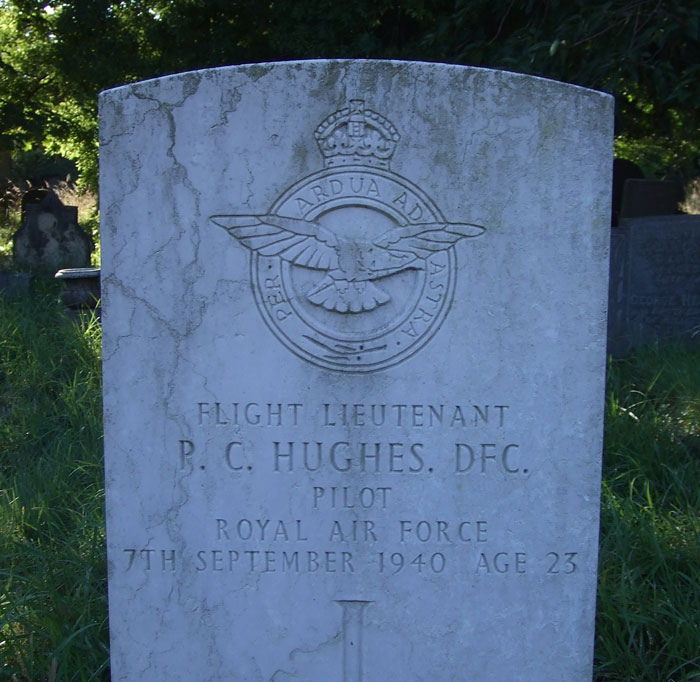The Airmen's Stories - F/Lt. P C Hughes
Patrick Clarence Hughes was born in Cooma, Australia on 19th September 1917, the son of Paterson Clarence and Catherine Hughes.He was the youngest of five boys and seven girls.
He was a keen sportsman, excelling at football and swimming. Hughes was educated at Cooma Public School until age twelve, when the family moved to Sydney.
He then enrolled at Petersham Boys School, going on to Fort Street High School.
On leaving he was employed in a jewellers shop in Sydney.
Hughes joined the Royal Australian Air Force in 1935 and began his flying training at Point Cook in Victoria. After graduation he was selected for a short service commission with the RAF. He travelled to the UK in 1937 and was posted to 2 FTS at Digby for his flying capabilities to be assessed.
Still wearing his RAAF uniform he was then posted to 64 Squadron at Martlesham Heath. When 234 Squadron was reformed at Leconfield on 30th October 1939 Hughes was promoted to acting Flight Lieutenant and sent there as a flight commander.
The squadron was posted to St. Eval in June 1940. On 1st August 'Pat', as he was known to all, married Kathleen (Kay) Brodrick of Hull at Bodmin Registry Office. Its believed that he had met Kay at the Beverley Arms Hotel in Beverley when he was briefly stationed at RAF Leconfield.
He was credited with sharing 234 Squadron’s first victory during the Battle, a Ju88 he shot down near Lands End on 8th July. On the 27th he damaged another and shared in damaging another on the 28th.

In August 1940 the Squadron moved to Middle Wallop. During the next few weeks his tactic of getting in close and getting out quickly ensured that he was always where the fighting was fiercest. On 15th August Hughes destroyed a Me110 and shared another, destroyed two Me109s on the 16th, two more on the 18th, two more on the 26th, three Me110s on the 4th September, two Me109s on the 5th and another probable on the 6th.
It was the following day, the 7th, that the squadron intercepted a large daylight raid on London comprised of 60 Do17s plus their Me109 escorts. Pat was leading his section and dived straight towards the raiders.
Shortly afterwards his Spitfire, X4009, was seen spinning down with part of a wing missing. The aircraft fell in a field at Sundridge, Kent. Pat's body, parachute unopened, fell in the back garden of a bungalow 100 yards away.
From eyewitness reports there is no doubt that his Spitfire was in collision with a Do17 that fell at a waterworks in the same area. Some eyewitnesses on the ground were convinced that they saw Pat deliberately ram the Dornier having used up his ammunition.
Another unresolved mystery is that it was common knowledge on the squadron that Pat's inseperable companion, a terrier called 'Butch', flew with him in action. The dog was never seen again after that day and it is widely believed that he died with his master.

Hughes was awarded the DFC (gazetted 22nd October 1940).
He was buried in St.James Churchyard, Sutton, Hull close to his wife's home.


**********************************************
In September 2005 two local residents, Des and Tony Hall, who had witnessed the drama as children, fulfilled a lifelong ambition by marking the site where Pat fell. A plaque (photo below) was placed on the wall of the bungalow that overlooks the garden. A service and flypast by vintage aircraft from Biggin Hill was organised by Gerry Burke.

Then in 2008 a memorial close to where Hughes fell and accessible to visitors was unveiled by the Shoreham Aircraft Museum.
( www.shoreham-aircraft-museum.co.uk/memorials-hughes.htm )

|